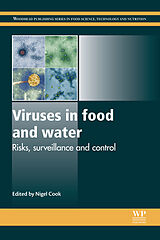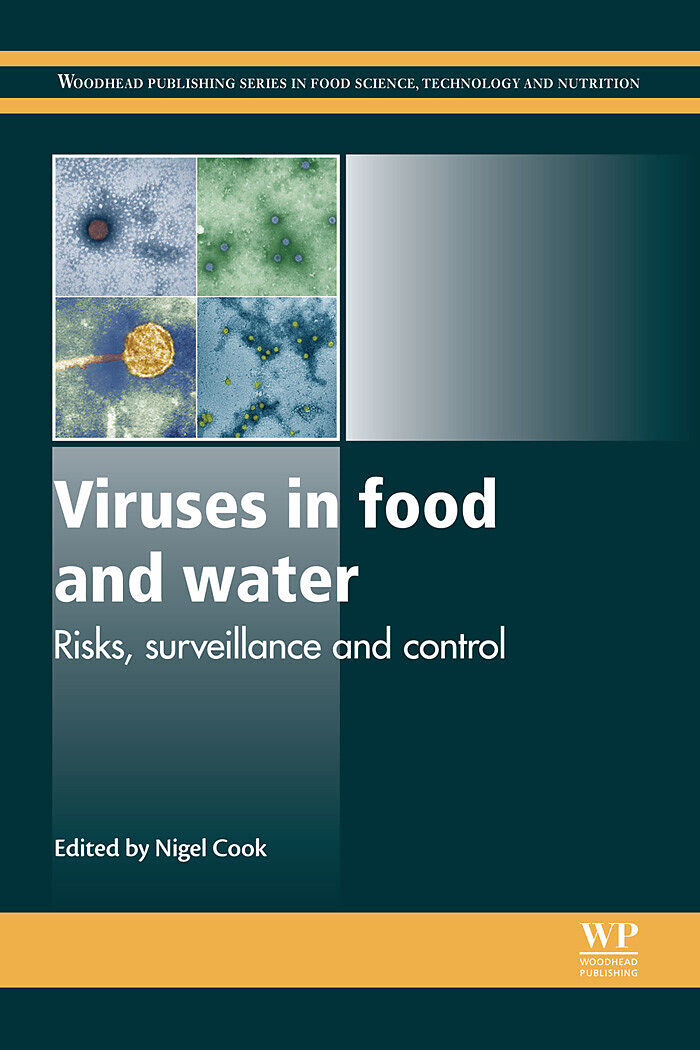Viruses in Food and Water
Format:
E-Book (EPUB)
EAN:
9780857098870
Untertitel:
Risks, Surveillance and Control
Genre:
Essen & Trinken
Herausgeber:
Elsevier Science & Techn.
Anzahl Seiten:
560
Erscheinungsdatum:
10.05.2013
Viruses can be highly infectious and are capable of causing widespread disease outbreaks. The significance of viral pathogens in food and waterborne illness is increasingly being recognised and viruses transferred by these routes are important areas of research. Viruses in food and water reviews the risks, surveillance and control of food and waterborne viral disease.
Part one provides an introduction to food and environmental virology. Part two goes on to explore methods of detection, surveillance and risk assessment of viruses in food and water; it includes chapters on molecular detection of viruses in foods and food processing environments, quality control in the analytical laboratory, and quantitative risk assessment for food and waterborne viruses. Part three focuses on virus transmission routes and control of food and water contamination. It contains chapters on fresh produce, shellfish and viral presence, and control methods in waste water and sewage. Finally, part four highlights particular pathogens including norovirus, hepatitis A and emerging zoonotic viruses.
Viruses in food and water is a standard reference book for microbiologists in academia, analytical labs and the food and water treatment industries, as well as environmental health professionals and researchers working on foodborne viruses.Explores methods of detection, surveilance and risk assessment of viruses in food and waterConsiders virus transmission routes and control of food and water contaminationHighlights advances in the understanding of specific pathogens, including norovirus, hepatitis A and rotaviruses and the advances in vaccine development
Inhalt
Contributor contact details Woodhead Publishing Series in Food Science, Technology and Nutrition Part I: An introduction to food and environmental virology Chapter 1: An introduction to food- and waterborne viral disease Abstract: 1.1 Introduction to enteric viruses 1.2 Food and water as vehicles of virus transmission 1.3 Outbreaks of food- and waterborne viral illness 1.4 Virus detection 1.5 Control of virus contamination of food and water Chapter 2: Prevalence of viruses in food and the environment Abstract: 2.1 Introduction 2.2 The prevalence of virus contamination in food and water 2.3 Gaps in current knowledge 2.4 Conclusion and future trends 2.5 Acknowledgements Part II: Detection, surveillance and risk assessment of viruses in food and water Chapter 3: Molecular detection of viruses in foods and food-processing environments Abstract: 3.1 Introduction 3.2 Molecular detection of viruses in foods: the process 3.3 Current issues in molecular detection of viruses in foods 3.4 Conclusion Chapter 4: Sampling strategies for virus detection in foods, food-processing environments, water and air Abstract: 4.1 Introduction 4.2 Virus monitoring at different levels of the food supply chain 4.3 The significance of water, air and surface sampling during food chain monitoring 4.4 Sampling strategy in relation to food- and waterborne outbreaks 4.5 Conclusion 4.6 Sources of further information and advice 4.8 Appendix: sampling from food and air Chapter 5: Molecular detection of viruses in water and sewage Abstract: 5.1 Introduction 5.2 Sample treatment: adsorption-elution methods 5.3 Sample treatment: ultrafiltration and ultracentrifugation 5.4 Key assays for virus detection 5.5 Advantages and disadvantages of polymerase chain reaction (PCR) and related methods 5.6 Current applications and results Chapter 6: Quality control in the analytical laboratory: analysing food- and waterborne viruses Abstract: 6.1 Introduction 6.2 Controls for the sample treatment step 6.3 Controls for the nucleic acid extraction step 6.4 Controls for the amplification step 6.5 Additional recommended controls 6.6 Reference materials 6.7 Conclusion Chapter 7: Tracing the sources of outbreaks of food- and waterborne viral disease and outbreak investigation using molecular methods Abstract: 7.1 Introduction 7.2 Challenges in food- and waterborne outbreak tracing and investigation 7.3 Microbial source tracking 7.4 Molecular-based source tracking 7.5 Molecular tracing in outbreaks 7.6 Conclusion Chapter 8: Quantitative risk assessment for food- and waterborne viruses Abstract: 8.1 Introduction 8.2 Quantitative microbiological risk assessments (QMRAs) and their outcomes 8.3 Data gaps and needs 8.4 Future trends 8.5 Conclusion Part III: Virus transmission routes and control of food and water contamination Chapter 9: Natural persistence of food- and waterborne viruses Abstract: 9.1 Introduction 9.2 Methods for studying persistence 9.3 General factors affecting the natural persistence of viruses 9.4 Persistence in aquatic environments 9.5 Persistence in soils 9.6 Persistence on food-related surfaces 9.7 Persistence in food 9.8 Acknowledgement Chapter 10: Occurrence and transmission of food- and waterborne viruses by fomites Abstract: 10.1 Introduction: the role of fomites in virus transmission 10.2 Occurrence and survival of viruses on fomites 10.3 Virus transfer and modeling transmission 10.4 Disinfection and other interventions to prevent fomite transmission 10.5 Future trends Chapter 11: Viral contamination by food handlers and recommended procedural controls Abstract: 11.1 Introduction 11.2 Role of food handlers in virus transmission 11.3 Current knowledge and hygiene practices among food handlers 11.4 Guidance documents on food hygiene 11.5 Guidelines on the application of general principles of food hygiene to the control of viruses in food 11.6 Designing Hazard Analysis and Critical Control Points (HACCP) with the viruses NoV and HAV in mind 11.7 Conclusion and future trends 11.8 Acknowledgement Chapter 12: Foodborne virus inactivation by thermal and non-thermal processes Abstract: 12.1 Introduction 12.2 Thermal processes 12.3 Non-thermal processes 12.4 Appropriateness of surrogates 12.5 Future trends 12.6 Sources of further information and advice Chapter 13: Preventing and controlling viral contamination of fresh produce Abstract: 13.1 Introduction: why food contamination occurs 13.2 Contamination of produce 13.3 Attachment, adsorption and internalization 13.4 Prevention 13.5 Recommendations 13.6 Additional intervention strategies 13.7 Future trends 13.8 Sources of further information and advice Chapter 14: Preventing and controlling viral contamination of shellfish Abstract: 14.1 Introduction 14.2 Human enteric viruses in the environment 14.3 Enteric viruses in sewage and shellfish 14.4 Survival of enteric viruses in the environment 14.5 Mitigation strategies and depuration 14.6 Current regulations 14.7 Conclusion Chapter 15: Viral presence in waste water and sewage and control methods Abstract: 15.1 Introduction: virus occurrence in wastewater 15.2 Natural treatment systems 15.3 Disinfection of wastewaters 15.4 Future trends Part IV: Particular pathogens and future directions Chapter 16: Advances in understanding of norovirus as a food- and waterborne pathogen and progress with vaccine development …

Leider konnten wir für diesen Artikel keine Preise ermitteln ...
billigbuch.ch sucht jetzt für Sie die besten Angebote ...
Die aktuellen Verkaufspreise von 2 Onlineshops werden in Realtime abgefragt.
Sie können das gewünschte Produkt anschliessend direkt beim Anbieter Ihrer Wahl bestellen.
Loading...
Die aktuellen Verkaufspreise von 2 Onlineshops werden in Realtime abgefragt.
Sie können das gewünschte Produkt anschliessend direkt beim Anbieter Ihrer Wahl bestellen.
| # | Onlineshop | Preis CHF | Versand CHF | Total CHF | ||
|---|---|---|---|---|---|---|
| 1 | Seller | 0.00 | 0.00 | 0.00 |
